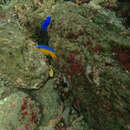Life Cycle
(
Inglês
)
fornecido por Fishbase
Oviparous, distinct pairing during breeding (Ref. 205). Eggs are demersal and adhere to the substrate (Ref. 205). Males guard and aerate the eggs (Ref. 205).
- licença
- cc-by-nc
- direitos autorais
- FishBase
Morphology
(
Inglês
)
fornecido por Fishbase
Dorsal spines (total): 12; Dorsal soft rays (total): 14 - 15; Analspines: 2; Analsoft rays: 12
- licença
- cc-by-nc
- direitos autorais
- FishBase
Trophic Strategy
(
Inglês
)
fornecido por Fishbase
Inhabits rocky inshore reefs (Ref. 9334). Territorial herbivore, feeds on farmed turf-algae within their territories (Ref. 57615).
- licença
- cc-by-nc
- direitos autorais
- FishBase
- Recorder
- Drina Sta. Iglesia
Biology
(
Inglês
)
fornecido por Fishbase
Adults inhabit rocky inshore reefs (Ref. 9334). Omnivorous (Ref. 9334). Oviparous, distinct pairing during breeding (Ref. 205). Eggs are demersal and adhere to the substrate (Ref. 205). Males guard and aerate the eggs (Ref. 205).
- licença
- cc-by-nc
- direitos autorais
- FishBase
Stegastes flavilatus
(
Inglês
)
fornecido por wikipedia EN
Stegastes flavilatus, commonly known as beaubrummel, is a damselfish of the family Pomacentridae. It is native to the tropical eastern Pacific Ocean, its range extends from Mexico, Baja California and the Gulf of California southwards to the Galapagos Islands and mainland Ecuador. It is found on rocky inshore reefs at depths ranging from 1 to 10 m (3 ft 3 in to 32 ft 10 in).[3]
Status
Stegastes flavilatus has a wide distribution and is common in many parts of its range, particularly the mainland coast, but less common around the Revillagigedo Islands, the Galapagos and Cocos Islands, and its populations appear to be stable. No particular threats to this species have been identified and the IUCN rates it as being of "Least Concern".[1]
References

- licença
- cc-by-sa-3.0
- direitos autorais
- Wikipedia authors and editors
Stegastes flavilatus: Brief Summary
(
Inglês
)
fornecido por wikipedia EN
Stegastes flavilatus, commonly known as beaubrummel, is a damselfish of the family Pomacentridae. It is native to the tropical eastern Pacific Ocean, its range extends from Mexico, Baja California and the Gulf of California southwards to the Galapagos Islands and mainland Ecuador. It is found on rocky inshore reefs at depths ranging from 1 to 10 m (3 ft 3 in to 32 ft 10 in).
- licença
- cc-by-sa-3.0
- direitos autorais
- Wikipedia authors and editors

